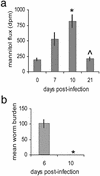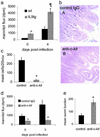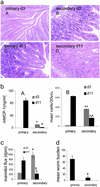Mast cells disrupt epithelial barrier function during enteric nematode infection
- PMID: 12796512
- PMCID: PMC164661
- DOI: 10.1073/pnas.1231488100
Mast cells disrupt epithelial barrier function during enteric nematode infection
Abstract
We have investigated the influence of mast cells on the barrier function of intestinal epithelium during nematode infection. Trichinella spiralis infection induces a strong type 2 cytokine-mediated inflammation, resulting in a critical mucosal mastocytosis that is known to mediate expulsion of the parasites from the intestine. The host response to infection is also characterized by an increase in mucosal leakiness. We show here that intestinal epithelial permeability is markedly elevated during infection, with kinetics that mirror the adaptive immune response to primary and secondary infection. Furthermore, we have identified degradation of the tight junction protein, occludin, thereby providing a mechanism for increased paracellular permeability during helminth infection. We further demonstrate by using anti-c-kit antibody and IL-9 transgenic mice that mast cells are directly responsible for increasing epithelial paracellular permeability and that mice deficient in a mast cell-specific protease fail to increase intestinal permeability and fail to expel their parasite burden. These results provide the mechanism whereby mucosal mast cells mediate parasite expulsion from the intestine.
Figures






Similar articles
-
Interleukin-9 is involved in host protective immunity to intestinal nematode infection.Eur J Immunol. 1997 Oct;27(10):2536-40. doi: 10.1002/eji.1830271011. Eur J Immunol. 1997. PMID: 9368607
-
In vivo exit of c-kit+/CD49d(hi)/beta7+ mucosal mast cell precursors from the bone marrow following infection with the intestinal nematode Trichinella spiralis.Blood. 2004 Apr 1;103(7):2655-60. doi: 10.1182/blood-2003-09-3146. Epub 2003 Nov 6. Blood. 2004. PMID: 14604954
-
A critical role for stem cell factor and c-kit in host protective immunity to an intestinal helminth.Int Immunol. 1996 Apr;8(4):559-67. doi: 10.1093/intimm/8.4.559. Int Immunol. 1996. PMID: 8671643
-
Innate immune response mechanisms in the intestinal epithelium: potential roles for mast cells and goblet cells in the expulsion of adult Trichinella spiralis.Parasitology. 2008 May;135(6):655-70. doi: 10.1017/S0031182008004319. Epub 2008 Apr 16. Parasitology. 2008. PMID: 18413001 Review.
-
The mast cell and gut nematodes: damage and defence.Chem Immunol Allergy. 2006;90:128-140. doi: 10.1159/000088885. Chem Immunol Allergy. 2006. PMID: 16210907 Review.
Cited by
-
Potential effector and immunoregulatory functions of mast cells in mucosal immunity.Mucosal Immunol. 2015 May;8(3):444-63. doi: 10.1038/mi.2014.131. Epub 2015 Feb 11. Mucosal Immunol. 2015. PMID: 25669149 Free PMC article. Review.
-
Mast Cells in Gut and Brain and Their Potential Role as an Emerging Therapeutic Target for Neural Diseases.Front Cell Neurosci. 2019 Jul 30;13:345. doi: 10.3389/fncel.2019.00345. eCollection 2019. Front Cell Neurosci. 2019. PMID: 31417365 Free PMC article. Review.
-
New Insight into Intestinal Mast Cells Revealed by Single-Cell RNA Sequencing.Int J Mol Sci. 2024 May 21;25(11):5594. doi: 10.3390/ijms25115594. Int J Mol Sci. 2024. PMID: 38891782 Free PMC article. Review.
-
Tight Junction Protein Occludin Is a Porcine Epidemic Diarrhea Virus Entry Factor.J Virol. 2017 Apr 28;91(10):e00202-17. doi: 10.1128/JVI.00202-17. Print 2017 May 15. J Virol. 2017. PMID: 28275187 Free PMC article.
-
Antibiotics Suppress Activation of Intestinal Mucosal Mast Cells and Reduce Dietary Lipid Absorption in Sprague-Dawley Rats.Gastroenterology. 2016 Nov;151(5):923-932. doi: 10.1053/j.gastro.2016.07.009. Epub 2016 Jul 18. Gastroenterology. 2016. PMID: 27436071 Free PMC article.
References
-
- Despommier, D. (1995) in Enteric Infection, eds. Farthing, M. J. G., Keutsch G. T. & Wakelin, D. (Chapman & Hall, London), Vol. 2, pp. 107-113.
-
- Lammas, D. A., Wakelin, D., Mitchell, L. A., Tuohy, M., Else, K. J. & Grencis, R. K. (1992) Parasitology 105, 117-124. - PubMed
Publication types
MeSH terms
Substances
Grants and funding
LinkOut - more resources
Full Text Sources
Other Literature Sources

